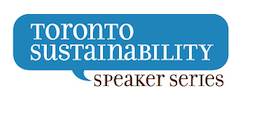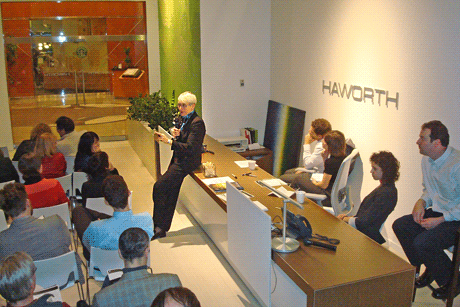 For decades HP has worked to manage its environmental impact by adopting environmentally responsible practices in product development, operations and supply chain. At a recent Toronto Sustainability Speaker Series event, Frances Edmonds, Director of Environmental Programs at HP Canada, told the story of how HP developed its sustainability program over the years.
For decades HP has worked to manage its environmental impact by adopting environmentally responsible practices in product development, operations and supply chain. At a recent Toronto Sustainability Speaker Series event, Frances Edmonds, Director of Environmental Programs at HP Canada, told the story of how HP developed its sustainability program over the years.
A company doesn’t magically become sustainable. A variety of strategies must be employed but the essential ingredients are always the same: a vision to reduce waste coupled with encouragement for employees to find innovative solutions for the uncertain journey that lies ahead.
Frances Edmonds framed her talk by first establishing Hewlett-Packard’s longstanding environmental focus. According to Edmonds, ‘sustainability is not an end state but a state of doing’. This is reflected in HP’s vision, which stresses a deep respect for the environment by reducing impacts today and using its influence to build a sustainable global economy for tomorrow. At HP sustainability is integral to the way that business is conducted.
 The ICT sector (information and communication technology) accounts for 2% of the world’s carbon footprint. Edmonds suggested that the ICT sector could not only reduce its own footprint, but also offer solutions to the world’s carbon problem. As the largest technology company in the world, HP is firmly focused on playing a key role in finding and implementing these solutions.
The ICT sector (information and communication technology) accounts for 2% of the world’s carbon footprint. Edmonds suggested that the ICT sector could not only reduce its own footprint, but also offer solutions to the world’s carbon problem. As the largest technology company in the world, HP is firmly focused on playing a key role in finding and implementing these solutions.
Edmonds highlighted how HP uses technology that automatically restricts an employee’s ability to book travel to other offices when advanced teleconferencing technology is available in both locations. This is a win-win as both carbon emissions and financial costs are simultaneously reduced.
Hewlett-Packard has shown leadership in responsible recycling of old technology and print supplies through its Planet Partners program in over 50 countries. An example of the Planet Partners initiative that Edmonds discussed is its inkjet recycling program introduced in 2005. Edmonds explained that while tremendous engineering innovation was required to design this process, the greater challenge in effectively recycling these cartridges and ‘closing the loop’ on their production and use proved to be convincing consumers to actively participate in the program. She went on to explain how this challenge was overcome by partnering with Staples so that consumers would be able to return the cartridges with minimal effort. In this example, resource reduction through recycling saves HP money and builds a stronger relationship with a valuable supply chain partner. It’s another sustainability initiative with a win-win outcome.

As HP’s printer cartridge recycling program became more established, a question arose that could not be ignored: How do we know for sure that recycling is better than using virgin plastic? The time had come to conduct a life cycle analysis (LCA) of the recycled inkjet cartridges, including the often ‘hidden’ factors of collection, transport and processing. When the LCA was complete, the findings eliminated any remaining doubt about the benefits of recycling. Edmonds shared the findings with the group: between 2005 and 2010 recycling reduced the carbon footprint of the inkjet cartridges from by 22%, cut fossil fuel use in half and reduced water use by a staggering 69%. Despite these impressive results, HP recognized that there is always room for further improvement and in the past year the process has been further improved such that the carbon footprint reduction since 2005 is now 33%, fossil fuel use has been cut by 62% and the water savings have increased to 89%.
Concluding the event, Edmonds reflected upon HP’s success and listed many of the factors that paved the road of its sustainability journey:
- HP has a long history of ‘doing the right thing’ and has had defined CSR values since 1957.
- Management structure encourages innovation and supports ‘doing the right thing’.
- HP accepts external responsibility for its products with its integrated principles of Extended Producer Responsibility.
- Employees are supported as they try new approaches, even when they fail.
- Employee engagement program helps them better understand the issues.
As promised at the event, Edmonds has provided HP’s white paper on procurement criteria for information technology (IT) products and services. Click here to read the report.

encouragement for employees to find innovative solutions for the uncertain journey that lies ahead.
It’s another sustainability initiative with a win-win outcome.
It’s another sustainability initiative with a win-win outcome.